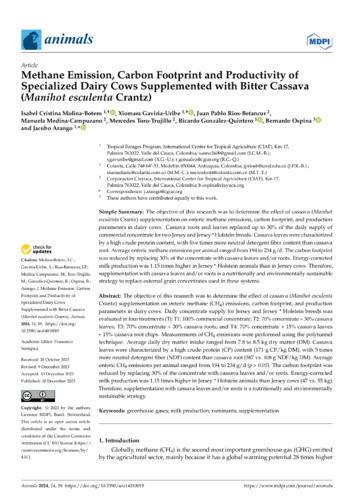The objective of this research was to determine the effect of cassava (Manihot esculenta Crantz) supplementation on enteric methane (CH4) emissions, carbon footprint, and production parameters in dairy cows. Daily concentrate supply for Jersey and Jersey * Holstein breeds was evaluated in four treatments (T): T1: 100% commercial concentrate; T2: 70% concentrate + 30% cassava leaves; T3: 70% concentrate + 30% cassava roots; and T4: 70% concentrate + 15% cassava leaves + 15% cassava root chips. Measurements of CH4 emissions were performed using the polytunnel technique. Average daily dry matter intake ranged from 7.8 to 8.5 kg dry matter (DM). Cassava leaves were characterized by a high crude protein (CP) content (171 g CP/kg DM), with 5 times more neutral detergent fiber (NDF) content than cassava root (587 vs. 108 g NDF/kg DM). Average enteric CH4 emissions per animal ranged from 194 to 234 g/d (p > 0.05). The carbon footprint was reduced by replacing 30% of the concentrate with cassava leaves and/or roots. Energy-corrected milk production was 1.15 times higher in Jersey * Holstein animals than Jersey cows (47 vs. 55 kg). Therefore, supplementation with cassava leaves and/or roots is a nutritionally and environmentally sustainable strategy.
Molina-Botero, I.C.; Gaviria-Uribe, X.; Rios-Betancur, J.P.; Medina-Campuzano, M.; Toro-Trujillo, M.; González-Quintero, R.; Ospina, B.; Arango, J.

